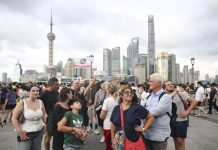BEIJING: For a typical Chinese New Year, Chinese people would make about 3 billion trips on planes, trains and cars for their annual return to hometowns. It has been the largest migration on the planet. Yet COVID-19 has disrupted that flow. In 2021, the Year of the Ox, the traveling pattern was once again unusual. Northern China was fighting sporadic COVID-19 outbreaks a few weeks into 2021. National authorities thus asked the public to avoid non-essential travel.
Many people canceled their trips due to the renewed restrictive measures. According to data from China State Railway, train rides dropped by more than 70 percent during the pre-Chinese New Year week. Ministry of Transport estimated that China will only see 1.7 billion trips during the holiday season, about 57 percent of the 2019 level. Airlines suffered particularly badly, with the average airfare down by one third from its peak in October last year. Nonetheless, as trips to low-risk regions and within the province are still permitted, traveling by car became a popular choice, particularly in the first- and second-tier cities. Car rental price more than doubled in the holiday week, according to Ctrip, China’s biggest travel firm.
Affluent consumers have fared rather well during the pandemic, but have been saving at a high rate due to limited opportunities to spend. The Chinese New Year holidays provided an outlet to release their pent-up demand. Lower-tier cities with beautiful outdoor scenery benefited the most while cities relying on indoor activities suffered – such was the case for Macao where gaming industry tumbled. According to data from LY.COM, an online travel agency, hotel booking in lower-tier cities for the first three days of the holiday season increased by nearly 30 percent from the 2019 level, particularly in Guangdong, Sichuan and Jiangxi provinces.
China’s retail sales in the first two months of 2020 tumbled down by 20.5 percent. We expect the same period in 2021 will perform much better but remain far below the level of 2019. Online sales will continue to outperform brick-and-mortar stores, while logistics industry has been booming. In normal years, logistics traffic during the Spring Festival would be only 10 percent of the yearly average, but this year the demand doubled. For the first time, almost all the logistics companies are on call for the whole holiday season, reaching 130 million units of parcels in the first two days of the holiday, up by 223 percent from last year. As people traveling across provinces must take multiple tests, both before departure and after arrival, their willingness to travel to other provinces is low. Consumption was therefore uneven across regions. For major labor exporters, including the three northeast provinces, their consumption boost from the holiday was much smaller than labor importing provinces, such as Guangdong and Anhui. Consistent with the migration pattern, southern and coastal China gained a bigger holiday boost than the north and the inland.
–The Daily Mail-CGTN News exchange item






